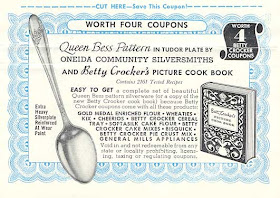Margarine was invented as a butter substitute by a French chemist in 1869 and was introduced to the U. S. in the 1870s. The dairy industry did everything it could could think of to ban and restrict the sale of margarine. The "
War on Margarine" lasted for more than 80 years in the U. S. and even longer in some other places. Strategies included banning the sale of margarine, slander, special taxes, and anti-color laws. Margarine is naturally white, and for many years the yellow color had to be added by the consumer because manufacturers were prohibited from or taxed on the sale of yellow margarine. Margarine, nevertheless, eventually become popular because it is cheaper than butter.

This postcard falls into two of my favorite postcard collecting categories: advertising and recipes. The front has a picture of the Durkee's Oleomargarine package and a recipe for Southern Spoon Bread using Durkee's Margarine. The back has a "Dear Mrs. Housewife" letter extolling the virtues of Durkee's Margarine's nutritional values, economy, flavor, and texture. This postcard is postmarked FEB26'42.

The next picture is of my wooden butter tub. When I bought this at an antique show, I asked the seller what it was used for. The seller didn't know, but when I got the tub home, I found the words "Wis. Butter Tub Co." on the bottom rim. My butter tub was probably never used for butter or other food. In the 1950s the
Wisconsin Butter Tub Company was still making these tubs, but some of them were being used by artists who decorated them for use as toy boxes, magazine containers, wastebaskets, sewing kits, and fireplace wood boxes.
I feel very lucky to have found this butter tub, because I have never seen another wooden butter tub in good condition. It is 15" high and has a 15-1/2" top diameter. It fits in very well with my pine furniture and is useful both for storage and as a small table.
































